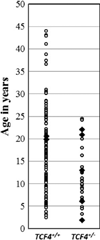The role of the TCF4 gene in the phenotype of individuals with 18q segmental deletions
- PMID: 21671075
- PMCID: PMC3215814
- DOI: 10.1007/s00439-011-1020-y
The role of the TCF4 gene in the phenotype of individuals with 18q segmental deletions
Abstract
The goal of this study is to define the effects of TCF4 hemizygosity in the context of a larger segmental deletion of chromosome 18q. Our cohort included 37 individuals with deletions of 18q. Twenty-seven had deletions including TCF4 (TCF4 (+/-)); nine had deletions that did not include TCF4 (TCF4 (+/+)); and one individual had a microdeletion that included only the TCF4 gene. We compared phenotypic data from the participants' medical records, survey responses, and in-person evaluations. Features unique to the TCF4 (+/-) individuals included abnormal corpus callosum, short neck, small penis, accessory and wide-spaced nipples, broad or clubbed fingers, and sacral dimple. The developmental data revealed that TCF4 (+/+) individuals were only moderately developmentally delayed while TCF4 (+/-) individuals failed to reach developmental milestones beyond those typically acquired by 12 months of age. TCF4 hemizygosity also conferred an increased risk of early death principally due to aspiration-related complications. Hemizygosity for TCF4 confers a significant impact primarily with regard to cognitive and motor development, resulting in a very different prognosis for individuals hemizygous for TCF4 when compared to individuals hemizygous for other regions of distal 18q.
Figures



References
-
- Amiel J, Rio M, de Pontual L, Redon R, Malan V, Boddaert N, Plouin P, Carter NP, Lyonnet S, Munnich A, Colleaux L. Mutations in TCF4, encoding a class I basic helix-loop-helix transcription factor, are responsible for Pitt–Hopkins syndrome, a severe epileptic encephalopathy associated with autonomic dysfunction. Am J Hum Genet. 2007;80(5):988–993. - PMC - PubMed
-
- Andrieux J, Lepretre F, Cuisset AG, Delobel B, Manouvrier-Hanu S, Holder-Espinasee M. Deletion 18q21.2q21.32 involving TCF4 in a boy diagnosed by CGH-array. Eur J Med Genet. 2008;51:172–177. - PubMed
-
- Bayley N. Bayley scales of infant and toddler development. 3rd edn. San Antonio: Harcourt Assessment Inc.; 2006.
-
- Brockschmidt A, Todt U, Ryu S, Hoischen A, Landwehr C, Birnbaum S, Frenck W, Radlwimmer B, Lichter P, Engels H, Driever W, Kubisch C, Weber RG. Severe mental retardation with breathing abnormalities (Pitt–Hopkins syndrome) is caused by haploinsufficiency of the neuronal bHLH transcription factor TCF4. Hum Mol Genet. 2007;16(12):1488–1494. - PubMed
Publication types
MeSH terms
Substances
Supplementary concepts
Grants and funding
LinkOut - more resources
Full Text Sources
Other Literature Sources
Medical

